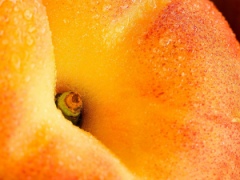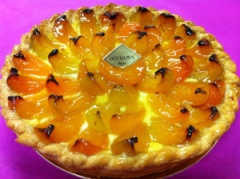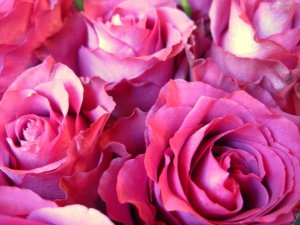Welcome to summer. Would you care for some lemonade? That is one facet of Cologne du Maghreb, a fragrance from Tauer Perfumes that begins as a brisk, chilled draught of citruses before turning much warmer and woodier.
As the name makes clear, Cologne du Maghreb is an eau de cologne. It originally debuted in 2011, and has just been re-released, primarily for the U.S. market, though it is also available at some European retailers. The fragrance is centered on botanical, natural, and absolute oils, but it also seeks to put a twist on the traditional, often European model for colognes by introducing some oriental elements as well. As the press release sent to me explains:
The Cologne du Maghreb is hand crafted and created in the traditional way of cologne making: With all natural and all botanical raw materials only. Essential oils, absolutes and resins find their way into this Cologne. Not more, not less. […][¶]
With this Cologne, Andy reaches out to the origins of perfume making in Europe, with an oriental twist, adding a storyline that goes beyond classical cologne splashes. The Cologne du Maghreb is a light fragrance that bridges occident and orient, and is evidence that the lands of the orient sun bring us more tones than just oudh and dark woods.
Contrasting a bright citrus chord, cistus and ambreine add depth and a natural amber gris shade. An exotic melody with cedarwood from the Moroccan High Atlas and hints of Java vetiver oil lingers in its base and lasts longer than the classical cologne citrus chord.
Like all colognes, the Cologne du Maghreb is a refreshing joy for the moment, and its herbaceous citrus accord is composed to last a short while, bright and fresh like the morning sun rising over a citrus garden in Morocco. The Cologne du Maghreb builds on the finest grade of Bergamot and lemon essential oils, combined with other carefully selected citrus treasures, such as luxurious neroli oil, the steam distilled essential oil of orange blossoms.
Lavender and rosemary essential oils build a herbaceous contrast to the fresh airy citrus choir and join rose absolute, rose essential oil and clary sage, bringing in a green ambery floral line and adding depth and character.
Notes: Citrus accord, cistus [labdanum amber], ambreine, cedarwood, java vetiver oil, bergamot, lemon, neroli, orange blossom, lavender, rosemary, rose absolute, rose essential oil, clary sage.
Cologne du Maghreb opens on my skin with crisp lemon and lime, resembling a very tart, chilled lemonade. It is lightly infused with vetiver which always manifests a peppermint aspect on my skin. While that’s rather common for me with vetiver, it isn’t the norm for a lot of people. Still, you should expect some definite greenness to accompany the cool citrus notes.
For a brief moment, Cologne du Maghreb’s opening bouquet calls to mind Dior‘s famous Eau Sauvage in vintage form. Both fragrances have sparkling freshness, vetiver, and citruses, but there are also differences. Cologne du Maghreb’s opening is much more heavily citric in focus, with less woodiness and vetiver. Also, to my memory, Eau Sauvage did not have any lime which is a sharper, more bitter element than bergamot and lemon. In any event, the similarity is fleeting, and soon passes.
Other elements lurk in Cologne du Maghreb’s background. There are hints of ambered sweetness, woodiness and herbaceousness, creating a blend that is largely fresh and crisp, but also with peeks of warmth. The herbal elements are mostly abstract. I never detect lavender or rosemary on my skin, though a muted, quiet touch of soapy clary sage is noticeable for brief moments in the opening 10 minutes.
As it fades, it makes way for the cedar which generally smells very green and fresh. The odd thing is that there is a definite whiff of muskiness to the note. In fact, in the opening few minutes, I had detected a sweatiness that had a strange woody character. It didn’t last for long, but I’m pretty sure it is the cedar which is responsible. There is something else, too: pencil shavings. Once in a while, the cedar smells like lemon-drenched pencil shavings as well. All of this is brief, though, as the wood note recedes to the periphery 30 minutes into Cologne du Maghreb’s development. When it returns, it is largely an abstract woodiness on my skin, without any strong or clearly delineated cedar tonalities.
For the most part, Cologne du Maghreb’s opening bouquet in the first hour is primarily that of sparkling, very zesty, chilled lemonade made up of lemons and limes, with peppermint vetiver, a dash of the oils from the fruits’ bitter peel, and the occasional suggestion of woodiness in the background. The herbaceousness soon fades away, as does the clary sage’s brief, muted touch of soapiness. At no time did I experience any orange blossom, though the rose appeared later for a short period.
To my surprise, the scent doesn’t feel like a thin cologne at all. Initially, it falls midway between a strong eau de toilette and a very airy, light, sheer eau de parfum. Botanicals can be very concentrated and potent, and it feels as though Mr. Tauer used very rich ones here. I have to say, I’m relieved, as I was rather dreading a Jo Malone-style of scent or a watery cologne. I have intense loathing and contempt for both.
Nonetheless, Cologne du Maghreb is not a potent scent when taken as a whole over the span of its entire development. The sillage is initially 2 inches with the use of 2 good sprays from a small vial. The number was pushed up by a fraction when I applied more, amounting to 2 large sprays from an actual perfume bottle, but Cologne du Maghreb is generally a soft fragrance. The projection dropped roughly 40 minutes into the perfume’s development to an inch. By the 90 minute mark, Cologne du Maghreb hovered just above the skin. It became a true skin scent on me at the end of the 2nd hour, and required me putting my nose actually on the skin to detect it.
At the start of the 2nd hour, Cologne du Maghreb begins to shift. A sweet, sherbet powder aroma takes over that smells exactly like Country Time yellow lemonade in its powdered form inside the box. I suspect those of you who are Americans with children know the precise scent in question. That does not mean that Cologne du Maghreb is powdery; it is not. But it smells like Country Time lemonade before you’ve added in the water. In addition, there is almost a fizzy quality to the scent as well. Cologne du Maghreb no longer feels as chilled or as brisk. Its bouquet is becoming deeper, warmer, and sweeter, even as the fragrance itself turns thinner, sheerer, and lighter. The lime and its slight bitterness has faded away. So has the cedar in any clear, distinct form.
Slowly, very slowly, Cologne du Maghreb turns deeper as a faint suggestion of something golden hovers at the edges. It is too nebulous on my skin to translate to actual labdanum, but it is clearly working indirectly to turn the fragrance warmer, darker, and more rounded now. By the middle of the 2nd hour, the citruses feel sun-sweetened and ripe, instead of sparkling, cool, or tart. The woodiness has returned, but it is largely abstract now instead of fresh, green, or musky cedar. Accompanying it is the subtle suggestion of something earthy. It does not smell of actual dirt or soil, and is extremely muted, but there is a sweet earthiness. I suspect it may stem from the labdanum amber this time, not the cedar.

“Lemon Tree” poster by Leah Saulnier, The Painting Maniac at pixels.com. (Website link embedded within.)
The note made me realise that Cologne du Maghreb is slowly transitioning away from lemonade powder and into something else: the scent of a full citrus tree. The main element continues to be the ripe lemons hanging heavily from the branch, but there is now also the vague sense of the wood and of the earth in which the tree is planted. There are even tiny splotches of greenness, like the leaves, from the lingering traces of vetiver in the background. It’s a symbolic, olfactory representation of a lemon tree in summer, from its fruits all the way down.
Cologne du Maghreb doesn’t change enormously after this point. The rose suddenly arrives on the scene about 3.25 hours into the perfume’s development. It is quite strong for about 15 minutes, before it retreats and joins the secondary elements that trail behind the lemon. For a short time, Cologne du Maghreb is a soft, sweet, lemon fragrance lightly flecked with roses, abstract woodiness, warmth, and a touch of minty vetiver. It’s all very gauzy and discreet on the skin.
Over the next hour, the other elements slowly fade away, until only the lemon is left standing in a cocoon of golden warmth with a hint of woodiness. In its final hour, the fragrance is a mere wisp of something warm and citrusy. All in all, Cologne du Maghreb lasted between 5 and 6.5 hours, depending on the quantity that I applied.
In the press materials that I was sent by Tauer Perfume’s U.S. distributor, Jeffrey Dame of Hypoluxe emphasized that true colognes are intended to be something refreshing and light for a hot, steamy day, and are meant to have intimate sillage. He also argues that true European colognes don’t last.
I disagree with him on that last issue, but, to be frank, I don’t understand the point of colognes as a general rule. My baseline for fragrances stemming back to my childhood is such that the scents considered to be powerhouses today are my “norm,” while eau de toilettes are my equivalent of a “cologne.” Actual colognes simply don’t register or compute for me with their 3-5 hours in average duration, watery thinness, intimate sillage, and need for endless reapplication. The point of spending money on such things eludes me entirely.
In all fairness, and to be as clear as possible, a number of those problems are not an issue here. Cologne du Maghreb is not like one of Jo Malone’s watery, ephemeral, banal, and utterly lifeless exercises in futility, but I’m still the wrong person to make any objective assessment of Cologne du Maghreb except in terms of how it smells. And it smells nice for a citrus fragrance. I can see how it may be very appealing on a hot summer’s day to go along with a cold glass of lemonade. I don’t wear citrus fragrances, but I appreciated how this one had a surprising woodiness and depth to it. In short, it wasn’t a squirt of thin lemon, and nothing else. It also lasted longer than I had expected.
There are already some reviews available for Cologne du Maghreb, and you may find them interesting as a comparative assessment. On Indiescents, one of Tauer’s Canadian retailers, the three comments range from “surprisingly pleasant” to “surprisingly woodsy.” All are positive:
- From the description, I was bracing myself for a face full of citrus, but I think the cedar note is the real star here, the central pillar that the dry botanicals and the bright citrus dance around. It smells ancient, sacred, dry, but alive, like a secret oasis in the desert or a temple on a mountaintop with offerings of fruit and dried flowers arranged on the altar. […]
- … Although nothing “sticks out” to me about this fragrance, it is definitely a true citrus, and one who has a trained nose can tell it is authentic in quality. Well done!
- I LOVE realistic citrus fragrances,with a good herbal twist..NO mens aftershave here,or lemon pledge aroma! This cologne is not very long lived..but its not made to be. It is the best new fragrance from this line I have tried so far:) […]

“Young Atlantic White Cedar Swamp” by Jason Howell at Motivepicture.com. (Website link embedded within.)
On Fragrantica, the one comment posted thus far is a rave review that talks about the “breathtaking” quality of the materials used in Cologne du Maghreb, and says it is one of the best colognes the poster has ever tried. I found the comment interesting because of a reference to “fetid” woodiness that echoes what I experienced with the cedar as well. “Karlovonamesti” writes:
A beautifully assembled cologne that dwells strongly on the fetid woodiness of cedar, lending it a duskier quality than your average EDC. There are complex top notes of orange, lemon, lime, bergamot, and neroli, with a significant labdanum heart, and plenty of wood in the base, which actually goes on for a while despite its cologne strength. Expect at least three hours out of this one, with a decent throw. Andy offers us the rarity of a complex cologne, and the experience of wearing it is unremittingly pleasurable. I admit that I’m not a fan of cedar in general, but the quality of materials and compositional skill on display here is breathtaking. This is one of the best colognes I’ve ever worn.
Luckyscent also has only one review listed thus far, and it is from someone who says Cologne du Maghreb is the first Tauer that they have ever fallen for:
The first of Tauer’s frangrances I have fallen deeply in love with. Many of his fragrances have a creosote note in them, which I recognized because I live in the desert and creosote bushes give off the smell before rain. Great for a preview of rain, not great for fragrance. But this one doesn’t have that creosote base. It is a perfect summer splash for hot summers. The blending is lovely, I get lime peel and then the herbaceous, cooling, dry (but not scratchy), refreshing scent. Not long lasting on me, but priced well enough to refresh during the day, which I like doing. Perfect if you work closely with people, it’s no sillage monster, or even aggressive. Lovely.
Speaking of pricing, Cologne du Maghreb costs $85 or €56 for a 50 ml bottle. As for availability, this is technically not a limited-issue fragrance. According to Hypoluxe, vendors will simply stock less of the cologne in winter, but it seems that its release this summer is largely aimed at the American market. As a side note, Cologne du Maghreb is the exact same formula as the original scent issued back in 2011.
Finally, Mr. Tauer has apparently decided to release a new cologne every summer, and the packaging will change as well. This year, Cologne du Maghreb came out in its original bottle which was a rectangular glass flacon, but the upcoming 2015 cologne (a woody vetiver scent) will be in the traditional Tauer pentagonal bottle. Cologne du Maghreb will change over to that packaging, too, next year. So, if you’re reading this review in a year from now and worry that Cologne du Maghreb may have been reformulated due to the differences in bottle, you have no cause for concern. It will be the same scent.
All in all, if you are looking for a refreshing fragrance for the summer that is more than mere citrus, give Cologne du Maghreb a sniff.
Disclosure: Perfume courtesy of Hypoluxe, the U.S. distributor for Tauer Perfumes. That did not influence this review, I do not do paid reviews, and my opinions are my own.








































